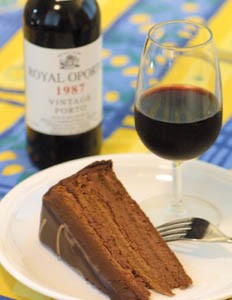Sweet Dreams
Dessert wines don’t have to be a sticky business
By Marina Wolf
DESSERT WINES are the forgotten finale. Until recently, restaurants gave them the last page of the wine list. At home, people think of stale sherry on top of their grandma’s fridge, and say no thanks. But as more restaurants bring dessert wines out from the back, pairing them with everything from chocolate cake to cheese or foie gras, consumers are finding that it’s worth getting to know the sweet stuff.
There’s a lot to learn, too, as dessert wines aren’t created using normal winemaking techniques. For example, a traditional German Eiswein is made from grapes that froze on the vine and then were hand-picked by lantern light. “It’s a very picturesque harvest,” says wine writer Heidi Yorkshire, “but it makes the Eiswein very expensive”–at least $80 for a 375-ml. bottle. More affordable alternatives are ice wines that have been made from artificially frozen grapes, as pioneered by Bonny Doon in the Santa Cruz area. This version of ice wine goes for between $14 and $20.
Or take botrytized wines, made from white varietals raised in cold, wet climes. The botrytis fungus usually shows up on its own, shriveling the host fruits, which must then be picked berry by berry. At Chateau d’Yquem in France’s Bordeaux region, the fields are picked over 10 times a season to get all the grapes at the height of their luscious decay. For fruits of this labor, people will pay hundreds of dollars for a bottle of Sauterne. But not every season is miserable enough to bring on the fungus. So once again, an American winery–Beringer in Napa Valley–came up with a more reliable and less expensive process than Mother Nature: pick the grapes and then apply the botrytis spore.
A basic grounding in dessert-wine background will assist you in understanding the flavor profiles of various wines. A later harvest generally means more ripeness. Botrytis adds a honeyed taste that, when combined with the fruit and floral notes of many white varietals, creates a heady, almost lightheaded, nectar. Tawny ports, which age on wood, have a smoky tinge and are made smooth by prolonged oxidation, or exposure to oxygen, which reduces the harshness of tannins.
IN PAIRING these wines with food, there are really only two main rules: the wine should be as sweet as or sweeter than a dessert; and a strong wine should accompany a very rich dish. Beyond that, you can simply emphasize the matching elements, either in flavor or in intensity. Or you may go for a more subtle approach, calling up contrasting or complementary qualities in the pairing.
Professionals who like dessert wines enjoy playing with these qualities in their pairings. Randy Goodman, co-owner and wine buyer for Wildwood Restaurant in Portland, Ore., sits down every month with his pastry chef, Jennifer Welshhons, to match wines with the changing dessert menu.
Goodman’s favorite pairing couples a chocolate pot de crème with cream sherry. Vanilla and cherries on top of the pot de crème match the sherry and provide a perfect foil for the rich chocolate, explains Goodman. Welsshons’ favorite match is a black-bottom banana cream pie flavored with chocolate, butterscotch, and a rum mousse, and paired with a 5-year-old Malmsey Madeira. “It’s strong enough to stand up to the chocolate and bananas, and also matches the butterscotch elements,” says Welsshons.
It’s not all sweets to the sweet, either. At Elka’s in San Francisco, sommelier Randall Grahm (the winemaker at Bonny Doon) often pairs dessert wines with items in other parts of the menu. The combination of sweet wines with savory foods was highly popular 100 years ago–Diamond Jim Brady, for example, drank Sauterne with oysters–and wine with cheese is a standard, port with Roquefort being one of the classic pairings. But Grahm takes a distinctly modern approach, guiding guests to a Pedro Ximenes sherry with the foie gras, or a German Riesling with Asian-inspired dishes.
“Asian ingredients are very savory and umame-intensive,” explains Grahm. “They have such a persistence of flavor that they will dominate dry wines. Something with low tannins and residual sugar is a much better match.”
When exploring the possibilities of dessert wines, take a page from restaurants: pour small. A normal pour on dessert wines is three ounces, but some restaurants will offer tastes to as small as half an ounce. Dessert wines are usually intense, in both flavor and aroma, and a few sips, with and without food, are enough to give you an idea of the wine.
Such caution leads to an obvious question: How do you store the wine between samplings? The ideal temperature, for opened or unopened bottles, is around 55 degrees, but everything else depends entirely on the wine. Certain dessert wines, such as Madeira or tawny port, can be open for up to a month and a half without losing flavor to oxygen; they’ve already been oxidized during the aging process. A vintage port, on the other hand, has been aged in an anaerobic, or oxygen-free, environment, so it’s more susceptible to oxidation.
The age of the wine is also an issue. Younger wines tend to have more acidity and free sulfites, which defend them against oxidation. But as the bottle ages, those things get used up in protecting the wine from the ravages of any air that might try to get in through the cork. The older the wine, the more quickly the bottle should be emptied.
So, if you ever run across a bottle of 1900 Sauterne, pour it quickly and enjoy.
From the April 5-11, 2001 issue of the Northern California Bohemian.











